|
The population of the little silver mining camp of Cerro Gordo, in
the 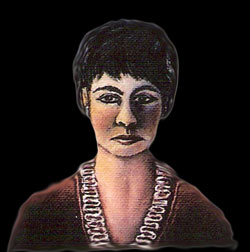 Inyo
Mountains towering above Owens Lake was predominately men in the
early days as these places were prone to be. But there were needs to
be met, and women the likes of Lola Travis, and Maggie Moore, soon
traversed up the steep and winding dirt road to set up shop and sell
their wares. Lola’s Palace of Pleasure and Madame Maggie’s Waterfall
helped to quench the thirst of the lonely miners in more ways than
one. Mud Hen, Horned Toad, Featherlegs, and the
Fenian were just a few of the girls that worked at these places
where fun, frolic, and fights helped earn the Fat Hill it’s place in
Inyo County headlines as a “man for breakfast” kind of town. Inyo
Mountains towering above Owens Lake was predominately men in the
early days as these places were prone to be. But there were needs to
be met, and women the likes of Lola Travis, and Maggie Moore, soon
traversed up the steep and winding dirt road to set up shop and sell
their wares. Lola’s Palace of Pleasure and Madame Maggie’s Waterfall
helped to quench the thirst of the lonely miners in more ways than
one. Mud Hen, Horned Toad, Featherlegs, and the
Fenian were just a few of the girls that worked at these places
where fun, frolic, and fights helped earn the Fat Hill it’s place in
Inyo County headlines as a “man for breakfast” kind of town.
Keeping House In Cerro Gordo
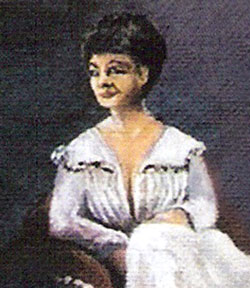 A few of the men brought the women in their lives to camp with them.
By 1870 the Inyo County Federal Census for Cerro Gordo Township No.
5 shows that out of 471 recorded residents, the total female
population was 58, ranging in age from two to 56 years. Out of
thirty six women age 18 and over, twenty two were Mexican,
twelve were white. Fifteen females of Hispanic/Indian descent were
under the age of 17, and of white descent there were nine. All women
age 18 and over listed their occupation as “keeping house”, the
politically correct term of the day for a domestic engineer, or
housewife.
A few of the men brought the women in their lives to camp with them.
By 1870 the Inyo County Federal Census for Cerro Gordo Township No.
5 shows that out of 471 recorded residents, the total female
population was 58, ranging in age from two to 56 years. Out of
thirty six women age 18 and over, twenty two were Mexican,
twelve were white. Fifteen females of Hispanic/Indian descent were
under the age of 17, and of white descent there were nine. All women
age 18 and over listed their occupation as “keeping house”, the
politically correct term of the day for a domestic engineer, or
housewife.
Five
households on the census were obviously run by females with no adult
males of the same last name listed near theirs. Of those households
where adult males were obviously present, be they father,
grandfather, uncle, brother, or son, 19 of the males listed their
occupation as miners. There were two households listed with males
working as farmers, one as farming agent, one mining superintendent,
one mining agent, one furnace manager, one assayer, two teamsters,
two mule packers, one hotel keeper and one butcher.
One
lone female, Anna Payson, age 11, recorded her occupation as
“keeping house” just as the women nearly twice her age and more. Next to
her name on the list, 48 year old Lewis Payson, more than likely her
father or grandfather, recorded his name, listing his occupation as a
teamster.
Transient Populations
Both male
and female populations in mining camps and towns were traditionally
transient, moving from one place to another depending on how much
ore was being pulled out and how much money was to be made from it.
A look at the census in neighboring Owens Valley communities shows
that some of the familiar names from Cerro Gordo had listed their
residency there instead of on the mountain.
For
modern travelers complaining about the difficulty to get to the
ghost of this silver camp in their cushy sports utility vehicles,
this may be hard to imagine. However it was quite common for even
the teenagers of the day to hop on a freight or brewery wagon and
head into Lone Pine for a celebration, as is evident from stories
told by Mrs. J. S. Gorman, in her tales recorded in previous
editions of our online magazine.
While
it’s doubtful mining mogul Mortimer Belshaw commuted on a day to day
basis from his recorded residence in the 1870 census of Bishop
Creek Township No. 4, it certainly is conceivable that he would
spend a few days here and there depending on where his business took
him. As a side note, it’s interesting that Mr. Belshaw’s wife and
children are not listed on the census with him. However, on the
mountain, a relative, John Belshaw and his wife, Lizzie, retained
residence. John’s occupation is listed as mining superintendent, and
Lizzie of course, as “keeping house”, like the rest of the female
population of Cerro Gordo.
Emma Louise Duval Spear
Though
her family name was transcribed wrong in the census, it’s obvious
that three year old Emma “Duvel”, is Emma Louise Duval Spear. Her
father, Charles, moved his family to a high point projected into an
Inyo canyon known as Duval Springs northwest of Cerro Gordo when
the great Lone Pine earthquake of 1872 hit. They stayed there for
several days while the tremors continued on.
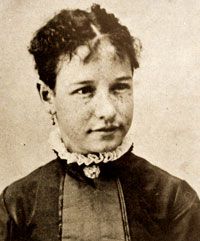 |
|
Emma
Duval
(Photo
courtesy Saga of
Inyo
County)
|
Emma
and her siblings would put their ears to the ground and listen to a
grumbling Mother Nature. On the solid rock mountain they, and the
communities that made up Cerro Gordo, were spared the devastation of
sandy soiled Owens Valley. Short biographies of Emma Duval, report
that her father Charles was responsible for bringing water into the
thirsty mining camp that was now boasting a population of over
3,800. The Duval’s retained a home in Lone Pine, apparently, but
spent a great deal of time at the springs, as well, so it was
natural that they would head up there for safety after the worst of
the earthquake was over.
Little
Emma grew up to be a fine Christian woman, so active within the
church down in Lone Pine, she was known as a home missionary. Two
years after the earthquake, still a young child, she met Reuben Cook
Spear. By 1888 she was his wife. “Reub”, was noted for his mine
dealings between Owens Valley and Bullfrog, Nevada. He and his
brothers also had interests in the nearly fading camp of Cerro
Gordo, as it rose again during the Louis D. Gordon Zinc era.
The Silver Queen of Cerro Gordo
The woman known
as Simons was also called the Silver Queen of Cerro
Gordo. She traveled through barren Death Valley with her two
sons and daughter inside the empty water barrels of the freight
wagon that she drove herself. She was on her way to meet her first
husband, Mr. Ryan, a miner who had set out ahead of her
with a train of burros on the way to Cerro Gordo. In her later
years, Father John Crowley met up with her at the Estelle mine,
where she lived with her daughter Marie and a man named Henry in an
isolated cabin at 8,000 feet near Cerro Gordo. The padre of the
desert described her as a woman who had proved her ability to shoot
straight and her willingness to sit up all night with a rifle across
her knees to defend the water springs and mines that she owned.
Fortunately for Cerro Gordo’s zinc magnate, Louis D. Gordon, Simons only resorted to sending him a court order that
read simply:
You
sir, turn over 50 gallons of water per day to this poor woman
and make it snappy.”
In response, Mr. Gordon sent a telegram to his superintendent, J. C.
Climo, that read:
March 9, 1907 - Restraining order is as Marby states. Furnish
specified amount of water tomorrow and Sunday and wire me fully
exact condition Saturday night and injury done to us by
furnishing specified amount of water. Use Bedford McNeil Code.
L. D. Gordon
Mr. Climo
was a man with a temper and not one to be pushed around. Gordon
reminded him with a brief note “I know how you feel but furnish
water in accordance with court order or we will be in contempt of
court. I am getting very busy and luck will change soon.” Climo
retained possession of the springs, but resigned himself to turning
over the 50 gallons of water each day. Over time order was cut to
thirty gallons of water, and eventually Louis d. Gordon got full
control of the springs, but for now, The Silver Queen of Cerro Gordo
had her fair share of sparkling H20.
Three Lone Women On The Mountaintop
It was
the fourth year of their marriage, and Walter and Mary Scheld were
living in Bishop, California, wondering where their next pay check
would be coming from. The newspaper arrived with an ad for
blacksmiths up at the Cerro Gordo Mines. It was pretty isolated on
the Cerro Gordo mountaintop, and Walter, better known as Bud,
probably hesitated at first. Mary looked at him and encouraged,
“It’ll only cost you two cents to find out about the job - two cents
postage.” This was January of 1926.
The job
was easy for Bud. All he had to do was sharpen the drills that the
miners were using to break through the hard rock. He’d sharpen those
drills until there were no more to sharpen that day, then he’d find
some place to take a nap. Meantime, his wife, Mary, did the best she
could living in a three room house on the mountain with her husband.
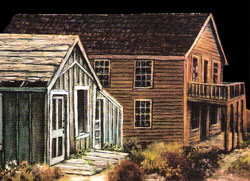
The
mountain was long past the heydays of men like Mortimer Belshaw &
Victor Beaudry. Even the Gordon zinc era was playing out.
Approximately 20 miners remained trying to pull out what they could
and make it worth their while. In addition to the miners there were
only two women besides Mary. The superintendent’s wife ran the
kitchen in the old American Hotel, which struggled to survive. To
help pass time and make a little pocket money at the same time, Mary
helped her in the kitchen and in the dining room. A third woman,
whom Mary would recall sixty years later as Mrs. Wheatley, “didn’t
do anything but have a baby.”
The
population wasn’t roaring in Cerro Gordo, but modern convenience had
arrived. Coal was used to heat and cook. Electricity provided lights
and radio. Everyone hung on edge as they listened to the
Dempsey-Tunney fight and placed bets on it. Wasn’t much else to do in
those days--the dance halls of Lola Travis and Maggie Moore were
long gone. Even the big pool hall in front of the tiny Scheld
residence was pretty much left to the ghosts, with the tables
standing minus their felt tops.
Water was
always a luxury in the high desert climate of Cerro Gordo.even
during more modern times. During
the Scheld’s 19 month stay, they were fortunate to get water
piped from the spring around the hill in town, then brought indoors
by bucket. Indoor plumbing was nonexistent of course. Women were
known for using too much water, so Mary, and the other two women
probably felt lucky, yet guilty to be allowed on the mountain.
Food
and other supplies came from the hamlet of Keeler on the shores of
Owens Lake far below town. When Mary needed something, she would
just write her shopping list on a piece of paper and put it on one
of the ore tram buckets. The next day everything that she needed
would arrive on the mountain the way the note had gone down.
During
the summer, Mary’s sister would come up and stay with her. When they
got bored, they would head into Lone Pine to watch a movie. After
one movie day, a storm hit and it was raining so hard they couldn’t
get back up the dirt road to the mines.
In August
of 1927 the owners of the banks in the Owens Valley, The Watterson
brothers, were put in jail when their books were examined and came up
short. The banks and the Cerro Gordo Mines were closed down. Bud,
out of a job once again, headed back to Bishop with his wife, Mary.
They moved to Merced within a month.
Sixty
years later, the Inyo Register interviewed Mary Scheld and
her sister Freda Tockey. Mary was 83 years old and happy to
reminisce about her time as one of the three women on the
mountaintop. “At one time there were thousands of people living
there,” Mary replied. “ I wasn’t very history minded when I was
there. I was trying to get ahead.”
“There
was no place to spend the money you made,” Freda Tockey told her
sister, “except for Lone Pine.”
Mary and Freda are just of the few of the women of Cerro Gordo who
left their mark on the town.
Beyond The Zinc Era
In 1948 a
woman named Barbara got in her brand new Chevrolet still heated from
a fight with her assistant director husband. Barbara was a script
girl for RKO movie studios, but had roots in the Owens Valley. She
found herself headed up to Lee Flat, just over the saddle from the
faded ghost of the Cerro Gordo Mines, on the Death Valley side of
the Inyos. It was very dark and very remote, and she wasn’t sure
where she was. She waited until morning and found a ramshackle cow
camp. Rough and tumble Wally Willson opened the door when she
knocked, and they fell in love immediately. Barbara divorced her
Hollywood husband and moved into the cow camp with Wally.
In
1949, he was approached by the last corporate owners of the Cerro
Gordo mines. Wally and Barbara found themselves caretakers, and
eventually owners, when mine owner W. C. Riggs had to declare bankruptcy. Wally
eventually died and Barbara married Fred Coman. When he died eight
years later, she married Jack Smith.
Keeping
up an abandoned mining camp is difficult financially at best. By
1973 Barbara and Jack were in need of money. Jack remembered his
niece Jody who was doing a little work in Hollywood on some projects
like the old Password game show. Jody drove up the steep and winding
Yellow Grade road to Cerro Gordo. She was in her fancy sports car,
wearing high heels and fancy clothes. Uncle Jack gave her a tour,
and she soon found herself saying that she would be glad to become a
part owner of Cerro Gordo.
By 1984,
Barbara Smith had been off of the mountain for about four years. The
ghost town of Cerro Gordo was in a terrible state of disrepair. Jody
remembered her roots in the Inyo County, and going to school in Big
Pine High School. She realized that this little mining town was her
opportunity to give back to the county that had given her a good
start on life. Jody Stewart moved on the mountain. Together with
Mike Patterson, whom she later married, they restored what buildings
they could and opened the town up for visitors day and overnight.
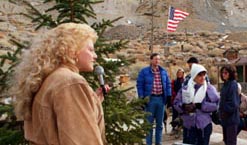 |
| Jody
talks to Cerro Gordo visitors. |
Jody died
in December 2001, leaving Mike Patterson alone on the mountain.
Jody’s spirit, and that of all the other women of Cerro Gordo
continues on in the life of the many modern women who volunteer
their blood, sweat, and tears, and the stories of the pioneers that
came before them so their daughters, and their sons can glimpse
into a time nearly forgotten.
Bibliography:
The Death Valley Red Light Chronicles--The Life And Times of Cerro
Gordo’s Lola Travis, Noted Conductress of a Bawdy Dance House
by Robin Flinchum
Desert Padre: The Life and Writings of Father John J. Crowley
1891-1940
by Joan Brooks
Mesquite Press
From This Mountain--Cerro Gordo
by Robert C. Likes and
Glenn R. Day
Chalfant Press
The Saga of Inyo County
by Southern Inyo American
Associations of Retired Persons
Taylor Publishing
Company, Covina, California
(Out of Print)
The Silver Seekers
by Remi Nadeau
Crest Publishers
1870 Census of Inyo County,
California
as transcribed
Cerro Gordo women and American Hotel
drawings
from original artwork by Robert C.
Likes
Newpaper Articles
Cerro
Gordo Bugle of Freedom
Volume 1 Issue 1 December
1994
Jody Stewart (Owner of
Cerro Gordo)
Courtesy Mike Patterson
Return To Cerro Gordo, 60 Years Later
Inyo
Register
Courtesy Laws Railroad
Museum
Inyo
Living
Woman
Tackles Project to Restore Cerro Gordo Town
by Jody Stewart
Courtesy Laws Railroad
Museum
And
Countless conversations
with Mike Patterson, Robin Flinchum, Robert C. Likes and the friends
of Cerro Gordo
More EHC
stories of the women of Cerro Gordo:
Lulu Waplehorst:
The First White Bride Of Cerro Gordo
by Cecile Page Vargo
Cerro Gordo And
It’s Ladies
by Maggie Moore Ho Dog
http://www.explorehistoricalif.com/august04.html
Growing Up On The Old Fat Hill
by Cecile Page Vargo
http://www.explorehistoricalif.com/growup.html |
